MV Thailand Aggressor, Similan IslandsContents of this Issue: MV Thailand Aggressor, Similan Islands Urban Diving after a Rain Storm Have You the Proper Travel Documents? Belize, Vieques, Indonesia, Molokai Award Winning Scuba Travel Guides Laurel Silver-Valker’s Sons Sue Well-Known Rebreather Diver in the News Again The Pros and Cons of Shark-Feeding Dives Does Human Interaction Affect Shark Behavior? Shark Dives Operating in The Bahamas Download the Responsible Shark and Ray Tourism Guide Great White Sharks are Back in Florida and You Can Track Them A Pocket Guide for Diving in Southeast Asia Woes Aboard the Sri Lanka Aggressor A Blue-Fingered Diver in Warm Waters PADI, from $200K to $700,000K in 32 Years Problems with Braided Regulator Hoses Editorial Office: Ben Davison Publisher and Editor Undercurrent 3020 Bridgeway, Suite 102 Sausalito, CA 94965 where have all the sharks gone? Soup! from the April, 2017 issue of Undercurrent
Dear Fellow Diver: Deciding to take a dive trip to Southeast Asia just three weeks before departure meant planning would be tricky, but the Thailand Aggressor had space, and Richelieu Rock, often listed as one of the world's top 10 dive sites, beckoned me. Though I knew the craft had mixed reviews, the Aggressor Fleet website offered a last-minute 50-percent-off a seven-night charter, which was too good to pass up, especially after I saw the whale shark images on their website. I was hooked.
Before getting out, I made a safety stop over a huge patch of dead coral empty of fish. Though it had been 12 years since the tragic Indian Ocean tsunami hit Thailand (the Similan Islands were the initial point of impact), the coral destruction was largely caused by the 2010 ocean hot streak in the Gulf of Thailand, which bleached massive areas of coral. Dive sites were closed for more than a year to allow the coral to recover. Earlier in the week, we dove the Similan Islands, which have fine beaches and small places to stay. Called the Nine Islands in the Yawi language, they are known by their numbers. Interestingly, many have massive boulders (about the size of a small SUV) along the shore, such as the impressive Elephant Head Rock in Donald Duck Bay (Similan Island #8). Underwater, the boulders -- some as large as a three-story house -- created a surreal topography, with nice arches and swim-thrus, but with few cracks where fish can hide. So, fish watching wasn't much. I did find a spearing mantis shrimp, a juvenile Napoleon wrasse, a giant barracuda and a striped sea snake over the course of nine dives.
The two cooks, Pa and Pee Phorn (I smile as I recall their names), kept us well fed. For the light breakfast before the first dive, I had coffee and cereal. Afterward, one could order eggs any way from Clive, accompanied by bacon and homemade bread as well as an amazing range of fruits. Because the large breakfast was enough to keep me going until dinner time, I skipped lunch one day and had soup and fruit the other days. Of course, I could not pass up the mid-afternoon snacks of pastries filled with meat, fish, or fruit. One day we had chocolate-covered ice cream. The three-course dinners (appetizer/soup, main dish, and dessert) were served in an elegant candlelight setting of white tablecloths and napkins, with the crew in uniform. The best meal of the trip: barbecued fish. Exquisite. A close second was the last night's filet mignon. Several dishes with sides of fresh veggies got "compliments to the chef" from us divers. Jinny kept pouring complimentary wine for those forgoing the night dive, and those who did dive received hot chocolate laced with Kahlua once done. I confess. My love for diving takes second place to my love for wine. In any case, night diving was restricted to the three nights spent at the Similan Islands. The nine guests comprised a diverse slice of the international community: a Pole living in Moscow, a Hungarian living in New Zealand, an American born in Cuba, couples from America and China, and a delightful Scottish couple -- wife Jenny, a nurse, entertained us with her hospital tales of treating the Queen. While I normally enjoy learning about the interests and experiences of my fellow liveaboard divers, this trip was different. With the U.S. election at hand, heated discussions ensued, and it was not until two days after the élection that we got word of the results. To a person, the non-American guests expressed dismay. We Americans were mixed. Being cut off from the news had been unnerving, and the lack of details made the results difficult to digest; it was like being told that a nuclear attack had taken place, but not the location.
Five more dives followed, each offering something new. One diver filled three pages with the names of fish that she had seen. But I saw no whale sharks or mantas; it was off season. Come back February to April, I was told. No matter, the waters were alive. There is a dark side to Richelieu Rock: no sharks. Their absence bothered me. I wondered whether it was just my luck, so afterward I checked the charter logs on the Aggressor website. Of the 16 trips between November 2016 to late March 2017, four had no sharks. Six sharks were the most seen on any given trip, with the most exciting findings being two leopard sharks and an eight-foot guitar shark. Shark-finning boats have taken their toll.
I had hesitated to book the Thai Aggressor (once serving as the PNG Star Dancer) because Undercurrent readers had reported problems with the boat. So I emailed the Aggressor office to ask about the state of repair. Wayne Hasson, president of the Aggressor Fleet, quickly replied that it had been in dry dock, and they had made improvements. Onboard, I found that the worn, funky carpets had been replaced, the cabins had engineered wood floors. Though clearly not luxurious as many newer liveaboards, the vessel was entirely adequate. The eight cabins are all on the main deck, with the camera table and diving deck aft. Go up one flight to the dining room, then up another to a covered sundeck, a hot tub, and two hammocks. My cabin, as well as the seven others, had two single beds -- I stored my luggage beneath mine -- and a cabinet for clothing and equipment. (The crew had placed a welcoming note on each bed, a towel rolled up in the shape of an elephant or so I thought -- and a set of blue lounge pants.) From my bed, I had a sea view through the large window. The decent-sized bathroom had a shower and toilet. The room AC controls worked well -- important, because I hate entering a freezing cabin after a dive. The enthusiastic and efficient dive crew filled tanks to capacity, with the nitrox mix spot-on, and gave dive briefings from slides. While often we dived off the platform, other dives required our walking down the stairs to the dive deck and making that clumsy and often tricky step into the inflatable dinghies. They divided us into two groups, one of four divers, the other of five. Once at the site, we backrolled into the water in unison. Dives with Bank and Clive as divemasters were a joy, since they always found interesting critters. Visibility was in the 40-foot range. Dives lasted more than 50 minutes with a maximum depth in the 85- to 95-foot range. My 3mm wetsuit and hooded vest kept me warm in the 82F water. After returning to the mother craft, the crew toted our gear to the diving deck and brought hot towels, helped us out of wetsuits, and rinsed and hung them. Not all dives were easy. Because of the strong current, on one of our last dives, we descended via the anchor line. Led into the current by Rong, I depleted my air too fast and decided to ascend when I hit 500psi, but since Rong was not looking at me, I used another 200psi kicking to him to signal my ascent. Fortunately, the current had subsided, and I burned the rest of my air in a safety stop, then surfaced with a spent tank. The boat was just a leisurely swim away.
The great service on the boat did not extend to the pickup arrangements upon arrival. My instructions stated that a staff member would meet me at the Phuket Airport international arrival exit, but two days before departure, I received an email stating that the pickup would be moved outside the arrival door, in front of the "TMB" money-changer, at 4 p.m. Since my flight arrived at 1 p.m., I was left with three hours of waiting around, an undesirable arrangement. For an hour I searched for the TMB money-changer, making inquiries of police and terminal employees, but none could help. Frustrated and annoyed, I decided to wait by the arrival door. My mood improved when another diver showed up, also confused about the arrangements. Eventually, the shuttle showed up, well after 4 p.m. The shuttle took us to Tap (or Thap or Tab) Lamu Pier, about 12 miles south of Khao Lak, and 45 miles (80 minutes) north of the Phuket Airport. The pier is unremarkable except for the presence of a large number of liveaboards and the Thai Navy. After the charter had ended, I stayed two more nights to explore the Khao Sok National Park. I did enjoy my trip aboard the Thailand Aggressor, though I was disappointed in the lack of sharks. But, as I must remind myself, there are no guarantees in diving. Richelieu Rock was exceptional, but not enough for me to recommend this trip with the long travel time. For high-octane diving closer to home, I suggest Socorro or the Sea of Cortez. You will not get much coral, but interactions with large sea life are guaranteed. -- LDV Our undercover diver's bio: "I have made more than 500 dives and been on 18 liveaboards since 2002: Galapagos, Great Barrier Reef, Bahamas, Coral Sea, Turk & Caicos, Socorro, Little Cayman, Palau, Sea of Cortez, Cocos, Truk, Philippines, Fiji, and now the Similan Islands. One of my aims in life is to continue diving forever."
|

I want to get all the stories! Tell me how I can become an Undercurrent Online Member and get online access to all the articles of Undercurrent as well as thousands of first hand reports on dive operations world-wide
| Home | Online Members Area | My Account |
Login
|
Join
|
| Travel Index |
Dive Resort & Liveaboard Reviews
|
Featured Reports
|
Recent
Issues
|
Back Issues
|
|
Dive Gear
Index
|
Health/Safety Index
|
Environment & Misc.
Index
|
Seasonal Planner
|
Blogs
|
Free Articles
|
Book Picks
|
News
|
|
Special Offers
|
RSS
|
FAQ
|
About Us
|
Contact Us
|
Links
|
3020 Bridgeway, Ste 102, Sausalito, Ca 94965
All rights reserved.

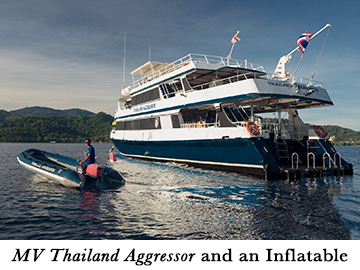 While four of us hung onto a pinnacle at 70 feet at Koh Bon, north of the Similan Islands, I thought about those whale shark images. I had been told that divers in another boat had seen whale sharks that morning, but I'd seen none, and now this was my last dive of the day. We had been drifting in a ripping current reminiscent of Palau's Blue Corner when we grabbed the rock, not an easy task without reef hooks. The current roared like a bullet train passing at full blast. But, nary a whale shark appeared, so after 10 minutes I let go, disappointed, and drifted off with my buddies. Maybe next time.
While four of us hung onto a pinnacle at 70 feet at Koh Bon, north of the Similan Islands, I thought about those whale shark images. I had been told that divers in another boat had seen whale sharks that morning, but I'd seen none, and now this was my last dive of the day. We had been drifting in a ripping current reminiscent of Palau's Blue Corner when we grabbed the rock, not an easy task without reef hooks. The current roared like a bullet train passing at full blast. But, nary a whale shark appeared, so after 10 minutes I let go, disappointed, and drifted off with my buddies. Maybe next time. 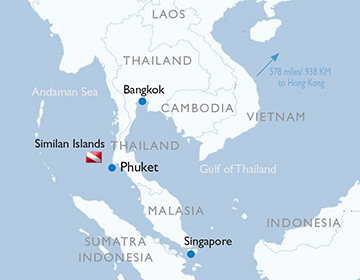 Although the diving at the Similans had been ho-hum, I had no complaints
about the topnotch all-Thai crew. Jinny, the cruise steward, was always looking
after us, keeping the cabins clean. Clive, the cruise director, made the trip
click with his attitude, good humor and personal tales. Both he and Bank, the dive
instructor, were excellent guides. The other divemaster, Rong, while excellent,
took off with his camera on his own on at least two dives, leaving the rest of the
group to wander and look for our own critters. That's not what divers pay for.
Although the diving at the Similans had been ho-hum, I had no complaints
about the topnotch all-Thai crew. Jinny, the cruise steward, was always looking
after us, keeping the cabins clean. Clive, the cruise director, made the trip
click with his attitude, good humor and personal tales. Both he and Bank, the dive
instructor, were excellent guides. The other divemaster, Rong, while excellent,
took off with his camera on his own on at least two dives, leaving the rest of the
group to wander and look for our own critters. That's not what divers pay for.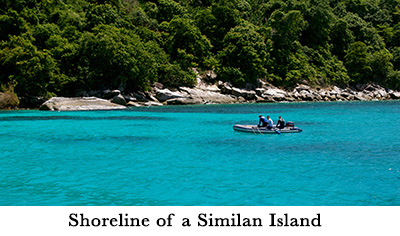 Diving Richelieu Rock was indeed the trip's highlight. Rising just a few feet above the surface, it's an amazing dive site, worthy of a place in a top 10 list. On my first dive, I was dazzled by a seamount alive with a profusion of red, pink, and orange soft corals, and dominated by stunning purple corals, creating a beautiful garden landscape. Anemones were everywhere. My fish ID skills were overwhelmed by the legions of fish surrounding me: all kinds of parrotfish, angelfish, triggerfish, and butterflyfish. A school of Chevron barracuda cruised overhead, while groupers and large Napoleon wrasses ambled past. Four cuttlefish hung around, with two cuddling (or is it cuttling?), before mating. A small school of lionfish hovered in one spot. Critters filled every nook and cranny.
Diving Richelieu Rock was indeed the trip's highlight. Rising just a few feet above the surface, it's an amazing dive site, worthy of a place in a top 10 list. On my first dive, I was dazzled by a seamount alive with a profusion of red, pink, and orange soft corals, and dominated by stunning purple corals, creating a beautiful garden landscape. Anemones were everywhere. My fish ID skills were overwhelmed by the legions of fish surrounding me: all kinds of parrotfish, angelfish, triggerfish, and butterflyfish. A school of Chevron barracuda cruised overhead, while groupers and large Napoleon wrasses ambled past. Four cuttlefish hung around, with two cuddling (or is it cuttling?), before mating. A small school of lionfish hovered in one spot. Critters filled every nook and cranny. 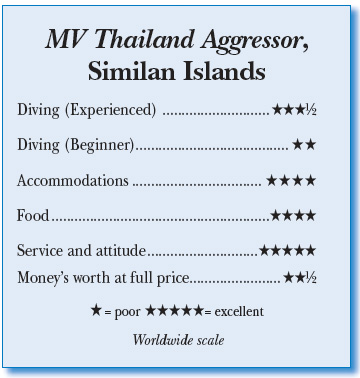 But, underwater there were plenty of
people. Endless day boats arrived from Khao
Lak, on the Thai mainland, causing a severe
traffic jam. One morning, seven cattle
boats arrived loaded with divers, and none
coordinated dive times. Underwater I would hear a boat approach and soon be surrounded
by divers. We had Richelieu Rock to ourselves only for the last two dives,
after the day boats had departed.
But, underwater there were plenty of
people. Endless day boats arrived from Khao
Lak, on the Thai mainland, causing a severe
traffic jam. One morning, seven cattle
boats arrived loaded with divers, and none
coordinated dive times. Underwater I would hear a boat approach and soon be surrounded
by divers. We had Richelieu Rock to ourselves only for the last two dives,
after the day boats had departed.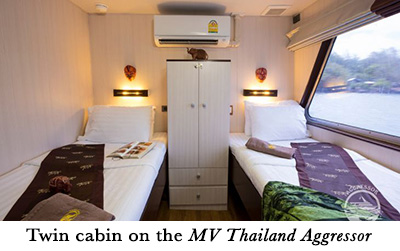 The early November weather was nearly perfect, to my good fortune. The Similan Islands and Richelieu Rock are closed during the rainy season, May to October, due to rough seas, so I knew I was on the cusp in early November. In fact, I learned that rough seas the previous week had made diving difficult, but we only had brief showers early in the week, and then the seas turned eerily flat.
The early November weather was nearly perfect, to my good fortune. The Similan Islands and Richelieu Rock are closed during the rainy season, May to October, due to rough seas, so I knew I was on the cusp in early November. In fact, I learned that rough seas the previous week had made diving difficult, but we only had brief showers early in the week, and then the seas turned eerily flat. Diving Compass: My half-off deal was $1645 (a last-minute deal, but $1000 discounts are common for this charter); round-trip flights from the Midwest $1135, with two overnight layovers in Hong Kong. . . . If you go through Hong Kong, best stay on the mainland; the Airport Express takes you to Central Station in just 25 minutes, with trains leaving every 10 minutes; the Hotel Ibis Hong Kong Central ($125 per night) is nearby. . . .Taxis in Hong Kong are cheap. Everybody speaks English. Hong Kong is fun, with something for everybody.
Diving Compass: My half-off deal was $1645 (a last-minute deal, but $1000 discounts are common for this charter); round-trip flights from the Midwest $1135, with two overnight layovers in Hong Kong. . . . If you go through Hong Kong, best stay on the mainland; the Airport Express takes you to Central Station in just 25 minutes, with trains leaving every 10 minutes; the Hotel Ibis Hong Kong Central ($125 per night) is nearby. . . .Taxis in Hong Kong are cheap. Everybody speaks English. Hong Kong is fun, with something for everybody.